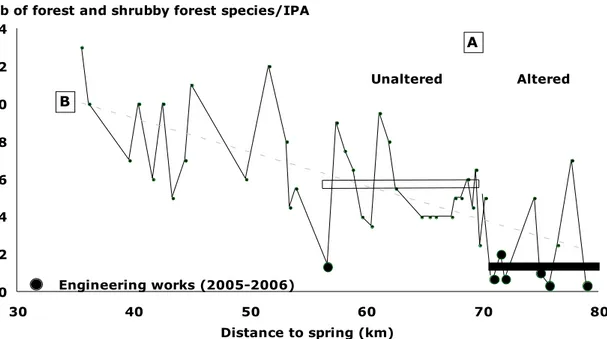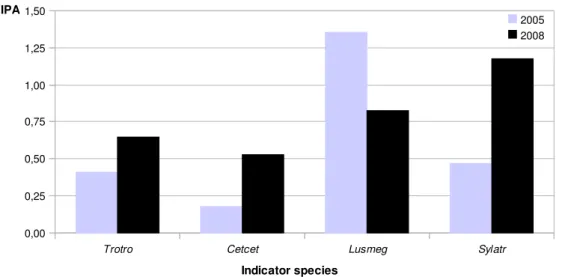Birds as bio-indicators and as tools to evaluate restoration measures
Jean Roché 1, Carlos Godinho 2, João E. Rabaça2, Bernard Frochot3, Bruno Faivre4, Ana
Mendes 5, Paula C. Dias ,6,7
1 53 Rue de l’Ecole, Le Sambuc, 13200 Arles, France, jea.roche@wanadoo.fr
2 LabOr – Laboratory of Ornithology, Institute of Mediterranean Agricultural and Environmental Sciences (ICAAM), University of
Évora, Apartado 94, 7002-554 Évora, Portugal
3 8 Rue Montesquieu, 21000 Dijon, France
4 UMR CNRS 5561 BioGéosciences, University of Burgundy, 6 Bd Gabriel, 2100 Dijon, France
5 Institute of Agricultural Sciences, Tech. Univ. Lisbon, Forest Research Centre, Tapada da Ajuda 1349-017 Lisboa, Portugal 6 Agropolis International, Avenue Agropolis, 34394 Montpellier cedex 5, France,
7 UMR CNRS 5175 Centre for functional and evolutionary ecology, Centre National de la Recherche Scientifique (CNRS), 1919 route
de Mende, F-34293 Montpellier cedex 5, France
Abstract
Within the RIPIDURABLE Project*, birds were used to characterize ecosystems*, to monitor environmental changes and to assess results of restoration measures. Bird surveys were carried out at different space and time scales using standardised point count methods on 8 watercourses in Portugal and France. Several aspects of riparian breeding bird community variation were assessed: along a decreasing gradient of vegetation complexity, along and upstream-downstream gradient, with different surrounding landscapes, with time, with management status, with time and management status, before and after river rehabilitation. Birds appear to be new and reliable indicators for assessing restoration of riparian ecosystems, complementary to those traditionally used.
*(see abstracts n° 205 and 112)
Keywords: birds, community, bio-assessment, monitoring, restoration, Mediterranean, riparian habitats Introduction
Rivers and streams are in many countries the only aquatic habitats with natural origin. Riparian habitats provide food and shelter resources for many species, they act as biological corridors, proving to be of crucial interest for biodiversity at different scales (e.g. Salinas et al. 2000, Rodewald and Bakermans 2006). However, these areas suffer from human activities through changes in land use, habitat fragmentation, erosion, channelization, or decrease in water quality (Décamps et al. 1988).
In order to assess quality and ecological integrity of streams and riparian habitats, it is necessary to develop standardized methodologies. Indicators can summarize or cluster complex environmental data, providing global images of biodiversity and its threats. Invertebrates, plants or fishes are commonly used, but they focus on the stream itself, neglecting the riparian ecosystems. Bird species-environment relationships proved to be good indicators to riparian habitats of Mediterranean rivers (Godinho et al. 2010) and can thus be used as models to assess quality, relevant perturbations and efficiency of restoration processes.
RIPIDURABLE* is an INTERREG IIIC Sud European Program involving 10 partners from Portugal, Spain, France and Greece. Scientists, technicians and local/regional authorities worked together to integrate knowledge, know-how and practice, towards a rational conservation management of riparian zones.
Within the RIPIDURABLE several rivers stretches (in Portugal, Greece and France) were selected for restoration actions. Bird surveys were conducted to: a) evaluate how and at what scales (space and time) bird communities provide reliable information about riparian ecosystem quality; b) assess restoration results.
Materials and methods
Bird surveys were carried out at different space and time scales using standardised point count methods (Blondel et al. 1981), on 8 watercourses in Portugal and France. Several different aspects of riparian breeding bird community variation were assessed: (1) along a decreasing gradient of vegetation complexity (Tagus Basin), (2) along an upstream-downstream gradient (Allier, Vidourle), (3) with different surrounding landscapes (Sado, Guadiana and Tagus Basin), (4) with time (Alcáçovas at a 10 years interval, Allier at 16 years interval), (5) with management status (Vidourle, photo 1), (6) with time and management status (Rhône delta at a 12 years intervals) and (7) before and after river rehabilitation (Gandum).
Photo 1: Engineering works along the river Vidourle (France)
Results and discussion
The diversity of works carried out on the RIPIDURABLE project shows that breeding bird communities are good indicators of the environmental condition of riparian ecosystems. Most of the recorded birds (60-75%) belong to forest and shrub species, which can be an indicator of riparian forest habitat conservation status. These communities are dependent of vegetation structure features, namely the width and high of the riparian strip and the number of vegetation layers present. It was recorded that, in average, largest forest strips (30 to 40m) harbored richer bird communities due to the assemblage of pure forest species, edge species and shrub species (Figure 1). According to these results the diversity of the breeding bird communities must be taken into account to assess riparian habitat restoration projects.
Figure 1: Mean number of forest and shrubby forest bird species by point count (IPA) with riparian forest
width along three French rivers: Rhône (black dots, n=32), Vidourle (grey dots n=33), Allier (white dots, n=33).
The bird studies carried out along river stretches of several kilometers highlight the need to integrate the upstream-downstream gradient in the data interpretation. It is difficult to assess restoration actions thought the simple area comparison (control area) with adjacent stretches (Figure 2A). It is essential to take into account the longitudinal gradient for a broader assessment of the rehabilitation to a natural state (Figure 2B); this implies the development of a large scale assessment protocol.
Figure 2: Comparison of altered and non altered river stretches (A) in a context of an upstream-downstream gradient (B) (from Roché 2007).
For monitoring schemes, data should be gathered prior to the interventions in order to establish a reference for future comparisons. Although data from short-term monitoring must be carefully interpreted, it can provide important information on how the restoration is going. In the Gandum stream (Portugal) we have seen between 2005 (before restoration) and 2008 an increase of the overall number of species and, more important, an increase for most of the selected bird indicator species (Figure 3). These changes were the result of the removal of alien species (mainly Arundo donax), decreasing the competition with the remains of native vegetation. With time, the growth of the planted vegetation will be able to support a richer bird community.
! " # $ % # #& $ ' ( ) * + + ,
Trotro Cetcet Lusmeg Sylatr 0,00 0,25 0,50 0,75 1,00 1,25 1,50 2005 2008 Indicator species IPA
Figure 3: Short term monitoring of restoration actions in Gandum stream (Portugal). Mean number of indicator species by point count (IPA) recorded before and after the restoration actions. Trotro – Wren; Cetcet – Cetti’s Warbler; Lusmeg – Nightingale; Sylatr - Blackcap In the long term studies, our monitoring detected changes in breeding species populations associated to riparian forest. In France, 31% of the species have significant change in their abundance between 1991 and 2006 along the river Allier (Roché et al., in press) and 19% along the Rhone river (1993-2006). Similar trends were recorded in Portugal along the rivers of the Alcáçovas basin, with species abundance changes of 18% between 1995 and 2006. Throughout the course of the Loire, Frochot et al. (2003) indicate significant fluctuations to 10% of species between 1990 and 2001. The knowledge of these fluctuations is crucial, although their origin can be external (extreme events during migration, severe winters, etc.), since their effect can be felt locally at sites undergoing restorations projects. Including them in the monitoring of the restoration actions will help to differentiate long term trends of the bird communities from consequences of restoration practices.
Conclusions
The birds appear to be, not only new and reliable indicators for assessing restoration of riparian ecosystems, but also complementary to those traditionally used. Additionally, birds are non aquatic organisms sensu stricto and integrate the terrestrial environment dimension. This is particularly relevant to the assessment of riparian areas due to the need of assess the river-valley interactions, characterizing all the hydrosystem. Birds provide a survey scale at the landscape habitat, larger than the strictly aquatic organisms. When compared to other groups, their survey is easy, standardized and less expensive. Therefore, we suggest a more generalized used of breeding bird communities as a tool to riparian environments restoration.
Acknowledgements
We thank INTERREG IIIC Sud (RIPIDURABLE project) and the Etablissement Public Loire, FEDER Loire and DIREN de bassin (STORI Project) for financial support, P-A Crochet, Ph Perret, E Dincuff, B Daurat, R Desbrosses, M-Ch Eybert, D Hermant, Th Geslin, P Marion and S Questiau for help in field work, and F Nunes, MT Ferreira and A Fabião for logistic support.
References
Blondel J., Ferry C. & Frochot B. (1981). Point counts with unlimited distance. Studies in Avian Biology 6: 414-420
Décamps H., Fortune M., Gazelle F. & Patou G. (1988). Historical influence of man on the riparian dynamics of a fluvial landscape. Landscape Ecology 1: 163-173
Frochot B., Eybert M.C., Journaux L., Roché J. & Faivre B. (2003). Les oiseaux de la Loire: évolution sur 12 années. Alauda 71(2): 179-190.
Godinho C., Rabaça J.E. & Segurado P. (2010). Breeding bird assemblages in riparian galleries of the Guadiana River basin: the effect of spatial structure and habitat variables. Ecological Research 25 (2): 283-294. DOI 10.1007/s11284-009-0655-9
Roché J. (2008). Etude des communautés d’oiseaux nicheurs le long du Vidourle dans un secteur soumis à l’aménagement des rives (2005 – 2007). Rapport CEFE/CNRS, 45 p.
Roché J., Faivre B. & Frochot B. (à paraître). Suivi Temporel des Oiseaux nicheurs en Rivière (programme « STORI ») : le cas de l’évolution sur 16 années (1991-2006) des communautés de l’Allier. Alauda.
Rodewald A.D. & Bakermans M.H. (2006). What is the appropriate paradigm for riparian forest conservation? Biological Conservation 128: 193-200
Salinas M.J., Banca G. & Romero T. (2000). Evaluating riparian vegetation in semi-arid Mediterranean watercourses in the south- eastern Iberian Peninsula. Environmental Conservation 27(1): 24-35


